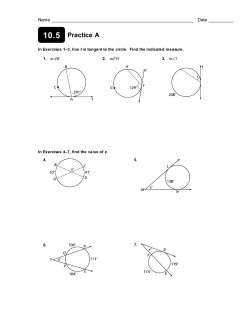
4.1 Angles and Radian Measure
4.1: Angles and Radian Measure An angle is formed by two rays that have a common endpoint. One ray is called the initial side and the other is called the terminal side. The endpoint that they share is the vertex of the angle. terminal side θ initial side vertex An angle can be acute (measure less than 90o), right (measure 90o), obtuse (measure between 90o and 180o), or straight (180o). An angle is said to be in standard position if its initial side lies on the positive xaxis and its vertex is the origin. Positive angles are generated by counterclockwise rotation, and negative angles are generated by clockwise rotation. A complete rotation in the counterclockwise direction is 360o, while a complete rotation in the clockwise direction is 360o. When an angle is in standard position, its terminal side can either lie in a quadrant or on an axis. If it lies in a quadrant, we say that the angle lies in that quadrant. e.g. An angle of 45o in standard position lies in Quadrant I, while an angle of 30o lies in Quadrant IV. If its terminal side lies on an axis, it is called a quadrantal angle. An angle of 90o, 180o, 270o, or any other multiple of 90o is a quadrantal angle. 1 In Geometry, we are accustomed to measuring angles in degrees, but in trigonometry we also use radians to measure angles. The radian measure of an angle in a unit circle (circle with radius 1) is equivalent to the length of the arc cut by the angle, which means that one rotation of a unit circle has radian measure equivalent to the circumference of the circle, or 2π. Therefore, 2π radians is equivalent to 360o, π radians is equivalent to 180o, π/2 radians is equivalent to 90o, and so on. 1 radian is equivalent to 180/π degrees, so to convert from radians to degrees, multiply the radian measure by 180/π. 1 degree is equivalent to π/180 radians, so to convert from degrees to radians, multiply the degree measure by π/180. Convert each of the following angles from radians to degrees. 1) π/4 2) π 3) 11π/6 Convert each of the following angles from degrees to radians. Express your answer as a multiple of π. 1) 60o 2) 300o 3) 135o To find the location of an angle, we can think of dividing the circle into increments of π/6, π/4, π/3, π/2, or π. Remember that angles measured counterclockwise are positive, and angles measured clockwise are negative. 2 Two angles are said to be coterminal if they have the same initial side and the same terminal side. Every angle has infinitely many coterminal angles. To find an angle that is coterminal with a given angle, if it is in degrees, simply add or subtract a multiple of 360, and if it is in radians, add or subtract a multiple of 2π. Find a positive angle less than 360o or 2π radians which is coterminal with each of the following: 1) 370o 2) 45o 3) 550o 4) 28o 5) 10π/3 6) 3π 7) 38π/9 8) 7π/4 The length of an arc intercepted by a central angle θ is equivalent to the radian measure of the angle if the circle has radius 1 (unit circle). However, if the radius of the circle is not 1, then the length of the arc is found by the following formula: s = rθ, where s is the length of the arc, r is the radius of the circle, and θ is the angle in radians. 1) Find the length of the arc in a circle of radius 12 cm, intercepted by a central angle of π/4. 2) Find the length of the arc in a circle of radius 8 feet, intercepted by a central angle of 60o. 3) Find the radian measure of the central angle of a circle of radius 6 yards that intercepts an arc of length 8 yards. 3 Since one revolution around the circle is 2π radians, we can express angular speed in radians per second as shown in the following examples: 1) 3 revolutions per second = 2) 10 revolutions per second = One common example of angular measure in a circle is on a clock or watch face. Determine the positive radian measure of the angle that the second hand of a clock moves through in the given time: 1) 15 seconds 2) 20 seconds Determine the number of degrees and the number of radians that a minute hand moves if it moves from 1) 12:00 to 3:00 2) 5:00 to 7:00 Determine the distance that the tip of a 5inch minute hand moves if it moves from 1) 12:00 to 3:00 2) 5:00 to 7:00 4
© Copyright 2025













